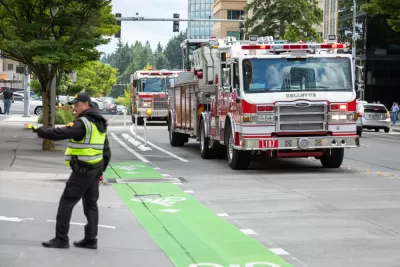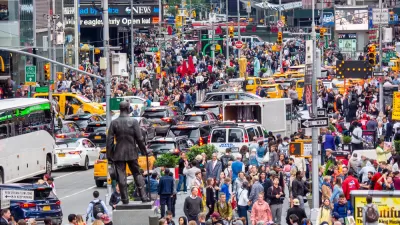Move Ahead Washington, a law approved by the Washington State Legislature earlier this year, is expected to have a huge effect on transportation planning and engineering on state-controlled roads.

Ryan Packer reports for The Urbanist on the details of the Move Ahead Washington law, also known as SB 5974, approved by the Seattle Legislature in March 2022. As explained by Packer, Move Ahead Washington is ambitious in its scope, requiring the Washington State Department of Transportation (WSDOT) to “identify gaps that exist in pedestrian or bike networks, and work with local jurisdictions to fill them” for every state transportation project that started design after July 1 of this year with a cost of over $500,000.
In the law’s own words, “In order to improve the safety, mobility, and accessibility of state highways, it is the intent of the legislature that the department must incorporate the principles of complete streets with facilities that provide street access with all users in mind, including pedestrians, bicyclists, and public transportation users…”
As noted by Packer, the law could have had a huge impacts on large projects completed before Move Ahead Washington took effect, such as the repaving of Seattle’s Lake City Way, also known as State Route 522. Other projects are already subject to the law’s mandate for complete streets, however, such as a project on the aging Omak Bridge across the Okanogan River in north-central Washington.
“Previously the bridge was planned to be refurbished and widened by removing sidewalks, with a separate pedestrian and bike bridge built just to the north. Now, in part due to this guidance, WSDOT is recommending a full replacement of the bridge with a bike and pedestrian facility included,” reports Packer.
FULL STORY: Washington Legislature Makes a Quantum Leap on Complete State Highways

Maui's Vacation Rental Debate Turns Ugly
Verbal attacks, misinformation campaigns and fistfights plague a high-stakes debate to convert thousands of vacation rentals into long-term housing.

Planetizen Federal Action Tracker
A weekly monitor of how Trump’s orders and actions are impacting planners and planning in America.

In Urban Planning, AI Prompting Could be the New Design Thinking
Creativity has long been key to great urban design. What if we see AI as our new creative partner?

California Creates Housing-Focused Agency
Previously, the state’s housing and homelessness programs fell under a grabbag department that also regulates the alcohol industry, car mechanics, and horse racing.

Chicago’s Ghost Rails
Just beneath the surface of the modern city lie the remnants of its expansive early 20th-century streetcar system.

Baker Creek Pavilion: Blending Nature and Architecture in Knoxville
Knoxville’s urban wilderness planning initiative unveils the "Baker Creek Pavilion" to increase the city's access to green spaces.
Urban Design for Planners 1: Software Tools
This six-course series explores essential urban design concepts using open source software and equips planners with the tools they need to participate fully in the urban design process.
Planning for Universal Design
Learn the tools for implementing Universal Design in planning regulations.
planning NEXT
Appalachian Highlands Housing Partners
Mpact (founded as Rail~Volution)
City of Camden Redevelopment Agency
City of Astoria
City of Portland
City of Laramie





























